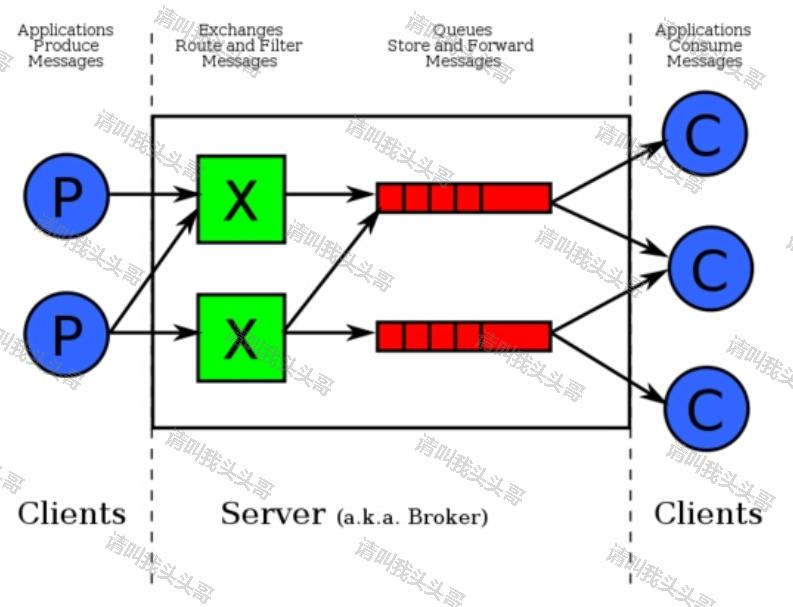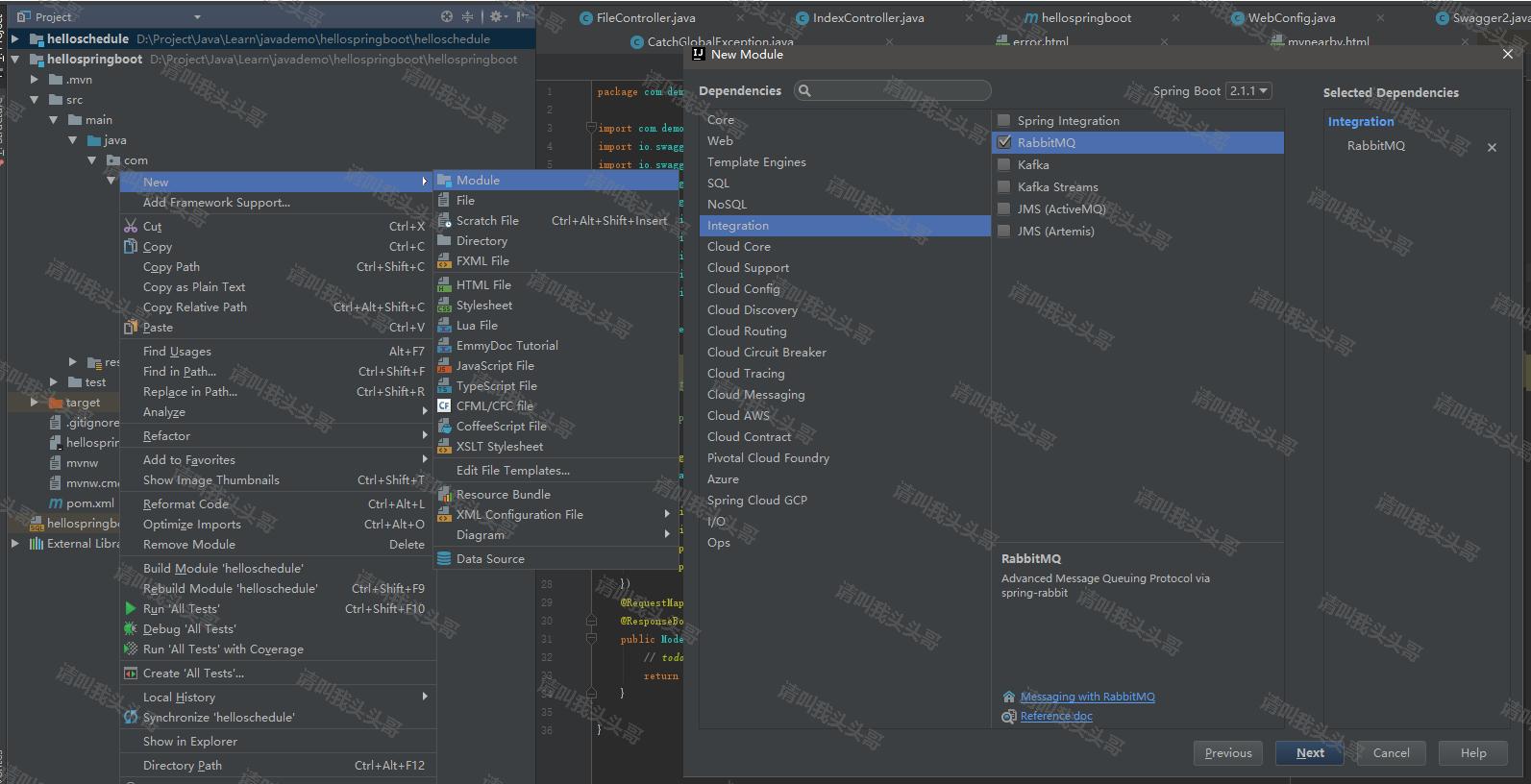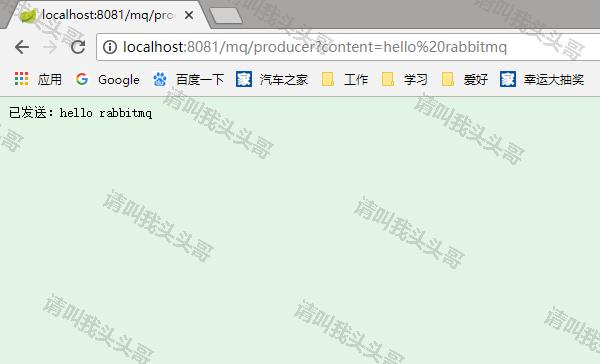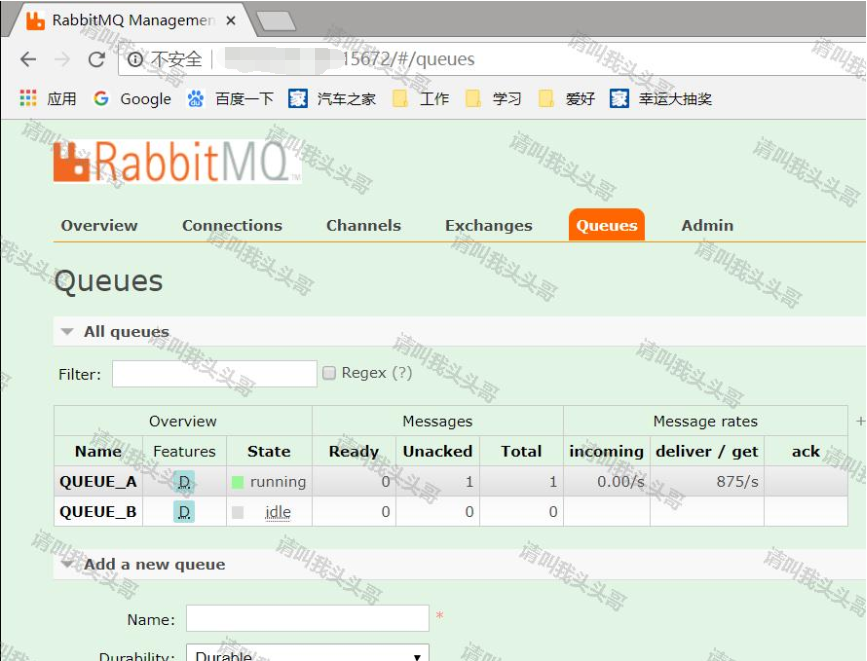RabbitMQ是一个在AMQP基础上完成的,可复用的企业消息系统。他遵循Mozilla Public License开源协议。RabbitMQ是流行的开源消息队列系统,用erlang语言开发。RabbitMQ是AMQP(高级消息队列协议)的标准实现。
消息中间件的工作过程可以用生产者消费者模型来表示.即,生产者不断的向消息队列发送信息,而消费者从消息队列中消费信息.
如果你还没有安装rabbitmq的,可以看看这篇《centos安装MQ》
不说了不说了,来一张图直截了当的看看MQ工作的具体过程:

开局一张图 故事全靠编.从上图可看出,对于消息队列来说,生产者,消息队列,消费者是最重要的三个概念,生产者发消息到消息队列中去,消费者监听指定的消息队列,并且当消息队列收到消息之后,接收消息队列传来的消息,并且给予相应的处理.消息队列常用于分布式系统之间互相信息的传递.
v基础概念
对于RabbitMQ来说,除了这三个基本模块以外,还添加了一个模块,即交换机(Exchange).它使得生产者和消息队列之间产生了隔离,生产者将消息发送给交换机,而交换机则根据调度策略把相应的消息转发给对应的消息队列.那么RabitMQ的工作流程如下所示:

关于rabbitmq几个基础名词的介绍:
Broker: 简单来说就是消息队列服务器实体。
Exchange: 消息交换机,它指定消息按什么规则,路由到哪个队列。
Queue: 消息队列载体,每个消息都会被投入到一个或多个队列。
Binding: 绑定,它的作用就是把exchange和queue按照路由规则绑定起来。
Routing Key: 路由关键字,exchange根据这个关键字进行消息投递。
vhost: 虚拟主机,一个broker里可以开设多个vhost,用作不同用户的权限分离。
producer: 消息生产者,就是投递消息的程序。
consumer: 消息消费者,就是接受消息的程序。
channel: 消息通道,在客户端的每个连接里,可建立多个channel,每个channel代表一个会话任务。
交换机的主要作用是接收相应的消息并且绑定到指定的队列.交换机有四种类型,分别为Direct,topic,headers,Fanout:
Direct: 处理路由键。需要将一个队列绑定到交换机上,要求该消息与一个特定的路由键完全匹配。这是一个完整的匹配。如果一个队列绑定到该交换机上要求路由键 “demo”,则只有被标记为“demo”的消息才被转发,不会转发demo.ooo,也不会转发test.123,只会转发demo。
Topic: 转发信息主要是依据通配符,将路由键和某模式进行匹配。此时队列需要绑定要一个模式上。符号“#”匹配一个或多个词,符号“*”匹配不多不少一个词。因此“audit.#”能够匹配到“audit.irs.corporate”,但是“audit.*” 只会匹配到“audit.irs”。
Headers: 根据一个规则进行匹配,在消息队列和交换机绑定的时候会指定一组键值对规则,而发送消息的时候也会指定一组键值对规则,当两组键值对规则相匹配的时候,消息会被发送到匹配的消息队列中.
Fanout: 路由广播的形式,将会把消息发给绑定它的全部队列,即便设置了key,也会被忽略.
v实战演练
2.1 创建MQ

注:若是现有工程引入MQ,则添加Maven引用。
<dependency> <groupId>org.springframework.boot</groupId> <artifactId>spring-boot-starter-amqp</artifactId> </dependency>
这里我们延续之前springboot系列博文中的例子hellospringboot,在已有项目中添加mq的Maven引用。
2.2 application.properties
在application.properties文件当中引入RabbitMQ基本的配置信息
# ----- MQ -------- # spring.rabbitmq.host=192.168.11.108 spring.rabbitmq.port=5672 spring.rabbitmq.username=guest spring.rabbitmq.password=guest
2.3 添加实体类MyModel
package com.demo.mq.model;import java.io.Serializable;import java.util.UUID;/**
* Created by toutou on 2019/1/1. */public class MyModel implements Serializable { private static final long serialVersionUID = 1L; private UUID id; private String info; public UUID getId() { return id;
} public void setId(UUID id) { this.id = id;
} public String getInfo() { return info;
} public void setInfo(String info) { this.info = info;
}
}2.4 添加RabbitConfig
package com.demo.mq.common;import org.springframework.amqp.core.Binding;import org.springframework.amqp.core.BindingBuilder;import org.springframework.amqp.core.DirectExchange;import org.springframework.amqp.core.Queue;import org.springframework.amqp.rabbit.connection.CachingConnectionFactory;import org.springframework.amqp.rabbit.core.RabbitTemplate;import org.springframework.beans.factory.annotation.Value;import org.springframework.beans.factory.config.ConfigurableBeanFactory;import org.springframework.context.annotation.Bean;import org.springframework.context.annotation.Configuration;import org.springframework.context.annotation.Scope;/**
* Created by toutou on 2019/1/1. */@Configurationpublic class RabbitConfig {
@Value("${spring.rabbitmq.host}") private String host;
@Value("${spring.rabbitmq.port}") private int port;
@Value("${spring.rabbitmq.username}") private String username;
@Value("${spring.rabbitmq.password}") private String password; public static final String EXCHANGE_A = "my-mq-exchange_A"; public static final String EXCHANGE_B = "my-mq-exchange_B"; public static final String QUEUE_A = "QUEUE_A"; public static final String QUEUE_B = "QUEUE_B"; public static final String ROUTINGKEY_A = "spring-boot-routingKey_A"; public static final String ROUTINGKEY_B = "spring-boot-routingKey_B";
@Bean public CachingConnectionFactory connectionFactory() {
CachingConnectionFactory connectionFactory = new CachingConnectionFactory(host,port);
connectionFactory.setUsername(username);
connectionFactory.setPassword(password);
connectionFactory.setVirtualHost("/");
connectionFactory.setPublisherConfirms(true); return connectionFactory;
}
@Bean
@Scope(ConfigurableBeanFactory.SCOPE_PROTOTYPE) public RabbitTemplate rabbitTemplate() {
RabbitTemplate template = new RabbitTemplate(connectionFactory()); return template;
} /**
* 针对消费者配置
* 1. 设置交换机类型
* 2. 将队列绑定到交换机
FanoutExchange: 将消息分发到所有的绑定队列,无routingkey的概念
HeadersExchange :通过添加属性key-value匹配
DirectExchange:按照routingkey分发到指定队列
TopicExchange:多关键字匹配 */
@Bean public DirectExchange defaultExchange() { return new DirectExchange(EXCHANGE_A);
} /**
* 获取队列A
* @return
*/
@Bean public Queue queueA() { return new Queue(QUEUE_A, true); //队列持久 } /**
* 获取队列B
* @return
*/
@Bean public Queue queueB() { return new Queue(QUEUE_B, true); //队列持久 } /**
* 把交换机,队列,通过路由关键字进行绑定
* @return
*/
@Bean public Binding binding() { return BindingBuilder.bind(queueA()).to(defaultExchange()).with(RabbitConfig.ROUTINGKEY_A);
} /**
* 一个交换机可以绑定多个消息队列,也就是消息通过一个交换机,可以分发到不同的队列当中去。
* @return
*/
@Bean public Binding bindingB(){ return BindingBuilder.bind(queueB()).to(defaultExchange()).with(RabbitConfig.ROUTINGKEY_B);
}
}2.5 添加消息的生产者MyProducer
package com.demo.mq.producer;import com.demo.mq.common.RabbitConfig;import com.demo.mq.model.MyModel;import org.slf4j.Logger;import org.slf4j.LoggerFactory;import org.springframework.amqp.rabbit.core.RabbitTemplate;import org.springframework.amqp.rabbit.support.CorrelationData;import org.springframework.beans.factory.annotation.Autowired;import org.springframework.stereotype.Component;/**
* Created by toutou on 2019/1/1. */@Componentpublic class MyProducer implements RabbitTemplate.ConfirmCallback { private final Logger logger = LoggerFactory.getLogger(this.getClass()); //由于rabbitTemplate的scope属性设置为ConfigurableBeanFactory.SCOPE_PROTOTYPE,所以不能自动注入
private RabbitTemplate rabbitTemplate; /**
* 构造方法注入rabbitTemplate */
@Autowired public MyProducer(RabbitTemplate rabbitTemplate) { this.rabbitTemplate = rabbitTemplate;
rabbitTemplate.setConfirmCallback(this); //rabbitTemplate如果为单例的话,那回调就是最后设置的内容 } public void sendMsg(MyModel model) { //把消息放入ROUTINGKEY_A对应的队列当中去,对应的是队列A rabbitTemplate.convertAndSend(RabbitConfig.EXCHANGE_A, RabbitConfig.ROUTINGKEY_A, model);
} /**
* 回调 */
@Override public void confirm(CorrelationData correlationData, boolean ack, String cause) {
logger.info(" 回调id:" + correlationData); if (ack) {
logger.info("消息成功消费");
} else {
logger.info("消息消费失败:" + cause);
}
}
}2.6 添加消息的消费者MyReceiver
package com.demo.mq.receiver;import com.demo.mq.common.RabbitConfig;import com.demo.mq.model.MyModel;import org.springframework.amqp.rabbit.annotation.RabbitHandler;import org.springframework.amqp.rabbit.annotation.RabbitListener;import org.springframework.stereotype.Component;/**
* Created by toutou on 2019/1/1. */@Component
@RabbitListener(queues = RabbitConfig.QUEUE_A)public class MyReceiver {
@RabbitHandler public void process(MyModel model) {
System.out.println("接收处理队列A当中的消息: " + model.getInfo());
}
}2.7 添加MyMQController
package com.demo.controller;import com.demo.mq.model.MyModel;import com.demo.mq.producer.MyProducer;import lombok.extern.slf4j.Slf4j;import org.springframework.beans.factory.annotation.Autowired;import org.springframework.web.bind.annotation.GetMapping;import org.springframework.web.bind.annotation.RestController;import java.util.UUID;/**
* Created by toutou on 2019/1/1. */@RestController
@Slf4jpublic class MyMQController {
@Autowired
MyProducer myProducers;
@GetMapping("/mq/producer") public String myProducer(String content){
MyModel model = new MyModel();
model.setId(UUID.randomUUID());
model.setInfo(content);
myProducers.sendMsg(model); return "已发送:" + content;
}
}2.8 项目整体目录

2.9 调试
2.9.1 在页面中请求http://localhost:8081/mq/producer?content=hello rabbitmq

2.9.2 查看http://ip:15672/#/queues的变化
关于RabbitMQ Management有疑问的,可以看上篇博文。《浅谈RabbitMQ Management》。

2.9.3 查看消费者日志记录

这样一个完整的rabbitmq实例就有了。
v源码地址
https://github.com/toutouge/javademo/tree/master/hellospringboot
原文出处:https://www.cnblogs.com/toutou/p/springboot_rabbitmq.html


 随时随地看视频
随时随地看视频




